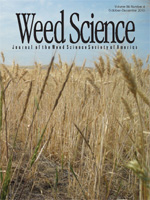Laboratory studies were conducted to compare the soil adsorption of aminopyralid and clopyralid with the use of batch-slurry and centrifugation assays. The calculated soil binding constants for both herbicides varied between the two techniques, but the centrifugation assay had a lower coefficient of variation compared to the batch-slurry assay. These results indicate that a centrifugation assay is a more accurate procedure for measuring the interaction of aminopyralid and clopyralid with soils. Aminopyralid adsorbed more tightly than clopyralid to six of the eight soils tested. Adsorption Kd values ranged from 0.083 to 0.364 for clopyralid and 0.106 to 0.697 for aminopyralid. Pearson correlation analysis indicated that binding of both herbicides was highly correlated to soil organic matter and texture but not to soil pH. On average, soil thin-layer chromatography indicated that aminopyralid was less mobile (Rf = 0.82) than clopyralid (Rf = 0.91), although both were mobile. These results suggest that aminopyralid will have a lower leaching potential than clopyralid. Lower potential aminopyralid soil leaching, coupled with low use rates, suggests it may be the herbicide of choice in areas where potential for leaching could be a concern.
Nomenclature: Aminopyralid; clopyralid.





